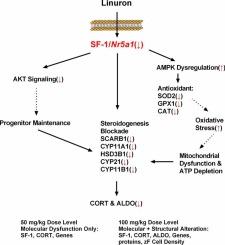产前暴露于利努龙可破坏雄性大鼠后代肾上腺甾体生成并诱发肾上腺功能不全
IF 2.9
Q2 TOXICOLOGY
引用次数: 0
摘要
Linuron是一种在某些地区常用的农业除草剂,由于其对人类和野生动物的内分泌毒性而引起人们的关注。虽然它的性腺毒性是确定的,但它对产前肾上腺发育的直接影响仍未被探索。妊娠sd - dawley大鼠从妊娠12-21天开始灌胃利努隆剂量(0、25、50、100 mg/kg/d)。Linuron降低50和100 mg/kg的血清CORT和100 mg/kg的ALDO,但不影响ACTH水平。在100 mg/kg剂量下,利努龙可降低肾上腺束状带细胞密度,但不改变其厚度。当剂量为50和/或100 mg/kg时,它也改变了与肾上腺功能有关的关键基因和蛋白质的表达。此外,100 mg/kg的linuron还能降低关键抗氧化酶(SOD2、GPX1、CAT)的表达。Linuron改变肾上腺激酶信号,激活AMPK,抑制AKT,对ERK1/2通路无影响。这些研究结果首次表明,linuron可能通过破坏类固醇生成、氧化应激和AKT/AMPK信号失调来破坏男性胎儿肾上腺发育和功能,突出了其作为发育性肾上腺干扰物的作用。本文章由计算机程序翻译,如有差异,请以英文原文为准。

Prenatal linuron exposure disrupts adrenal steroidogenesis and induces adrenal insufficiency in male rat offspring
Linuron, a commonly used agricultural herbicide in certain regions, has raised concerns due to its endocrine toxicity in humans and wildlife. While its gonadal toxicity is established, its direct impact on prenatal adrenal development remains unexplored. Pregnant Sprague-Dawley rats received linuron doses (0, 25, 50, 100 mg/kg/day) by oral gavage from gestational days 12–21. Linuron reduced serum CORT at 50 and 100 mg/kg and ALDO at 100 mg/kg but did not affect ACTH levels. At 100 mg/kg, linuron decreased cell density in the adrenal zona fasciculata without changing its thickness. It also altered the expression of key genes and proteins involved in adrenal function at 50 and/or 100 mg/kg. Additionally, linuron reduced the expression of key antioxidant enzymes (SOD2, GPX1, CAT) at 100 mg/kg. Linuron altered adrenal kinase signaling, activating AMPK but suppressing AKT, with no effect on ERK1/2 pathways. These findings reveal, for the first time, that linuron disrupts male fetal adrenal development and function likely through impaired steroidogenesis, oxidative stress, and dysregulated AKT/AMPK signaling, highlighting its role as a developmental adrenal disruptor.
求助全文
通过发布文献求助,成功后即可免费获取论文全文。
去求助
来源期刊

Current Research in Toxicology
Environmental Science-Health, Toxicology and Mutagenesis
CiteScore
4.70
自引率
3.00%
发文量
33
审稿时长
82 days
 求助内容:
求助内容: 应助结果提醒方式:
应助结果提醒方式:


